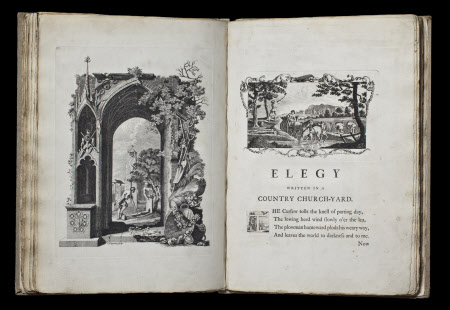Designs by Mr. R. Bentley, for six poems by Mr. T. Gray.
Thomas Gray (1716-1771)
Category
Books
Date
1766
Materials
Place of origin
London
Order this imageCollection
Anglesey Abbey, Cambridgeshire
NT 3070784
Summary
Designs by Mr. R. Bentley for Six Poems by Mr. T. Gray, London: printed for J. Dodsley, 1766. Binding: Eighteenth-century original paper-backed blue-grey paper boards, paper spine.
Full description
Richard Bentley (1708-82) first met Horace Walpole in 1750, and swiftly became a member of the Committee of Taste which helped the former prime minister’s son to develop Strawberry Hill, his Gothic fantasy house on the banks of the Thames near Twickenham. Bentley, himself another Twickenham resident, was the son of Dr Richard Bentley (1662-1742), Master of Trinity College, Cambridge, one of the most distinguished classical scholars of Georgian England, and also Master of the King’s Libraries – a post he surrendered to his 16-year-old son in 1725, in one of the more glaring examples of nepotism of the era. Bentley Junior was forced to reign from the sinecure in the aftermath of the disastrous Ashburnham House fire of 1731, which resulted in the destruction of many of the priceless manuscripts assembled by the Jacobean antiquarian Sir Robert Cotton, bequeathed to the nation by his grandson in 1700. This celebrated book – often described as the most sophisticated piece of book illustration produced in Georgian England – was very much a joint project, with the poet Gray dragooned into co-operating by the enthusiasm of his two friends. It was to originally have been entitled ‘Poems by Thomas Gray, with Designs by Richard Bentley’, but Gray objected to this, writing to the original publisher Robert Dodsley in February 1753: ‘I am not at all satisfied with the title. To have conceived that I publish a Collection of ‘Poems’ (half a dozen little matters...) thus pompously adorned would make me appear very justly ridiculous. Walpole, in turn, was grumpy about the compromise title which was eventually agreed on, taking particular umbrage at the use of the word ‘Mr’ (‘one of the Gothicisms I abominate’). But for all that, he kept the original drawings which his most prized treasures in the Glass Closet at Strawberry Hill. Bentley seems to have been at work on these drawings by June 1751 and had finished them by the summer of the following year, although the first issue of the original edition did not appear until May 1753. The exquisite copperplate engravings were done by Johann Sebastian Müller and Charles Grignion; there were three different issues in 1753, and further editions using the same plates followed in 1765, 1766, 1775 and 1789. The six poems were the ‘Ode of the Spring’, a mock-elegy ‘Ode on the Death of a Favourite Cat, Drowned in a Tub of Gold Fishes’, the ‘Ode on a Distant Prospect at Eton College’, ‘An Elegy Written in a Country Courtyard’, ‘A Long Story’ and the ‘Hymn to Adversity’. Fittingly, Bentley’s illustrations for the ‘Elegy’ have always been the most famous of the set, and the only ones wholly in the Gothic taste. Text adapted from Mark Purcell's entry in ‘Treasures from Lord Fairhaven’s Library at Anglesey Abbey’, National Trust, 2013, cat. 11, pp. 64-5.
Bibliographic description
[8]p., 35 leaves, [4], 39-55, [1] p., [6] leaves of plates : ill. ; 4to. Provenance: 1. Nineteenth-century armorial bookplate: John Waterhouse Halifax. 2. Twentieth-century armorial bookplate, large variant, signed Badeley 1930: Urban Huttleston Rogers Broughton [i.e. Urban Huttleston Rogers Broughton, 1st Baron Fairhaven (1896-1966), of Anglesey Abbey]. Binding: Eighteenth-century original paper-backed blue-grey paper boards, paper spine.
Provenance
Armorial bookplate of John Waterhouse Halifax, nineteenth century; with a collation note of Bernard Quaritch Ltd. Acquired by Huttleston Rogers Broughton, 1st Lord Fairhaven (1896-1966) and then bequeathed by him to the National Trust with the house and the rest of the contents in 1966.
Makers and roles
Thomas Gray (1716-1771), author Richard Bentley (1708 - 1782), illustrator
References
Mark Purcell, William Hale and David Person, Treasures from Lord Fairhaven’s Library at Anglesey Abbey, Swindon: National Trust; London: Scala Arts & Heritage Publishers, 2013., pp. 64-5
